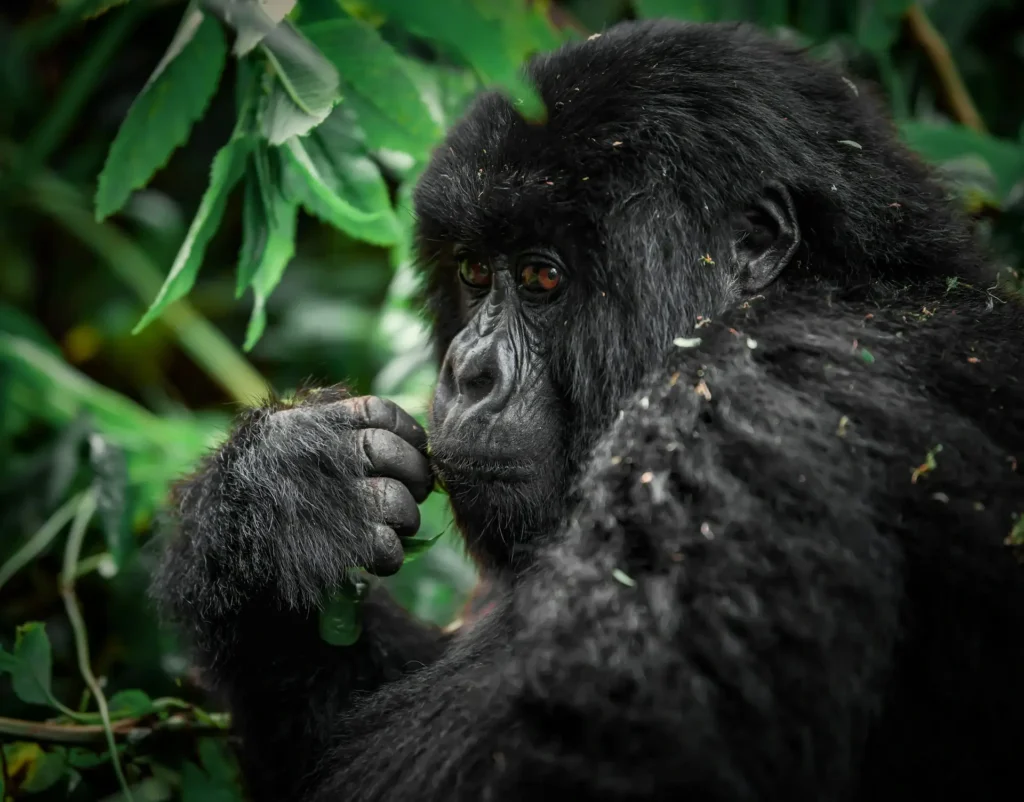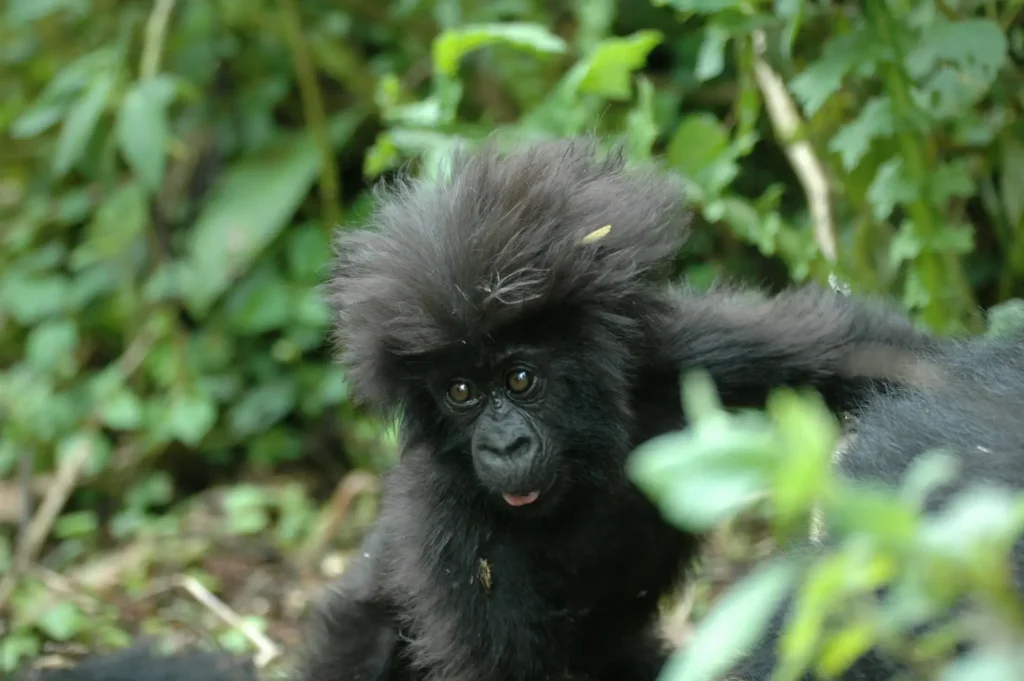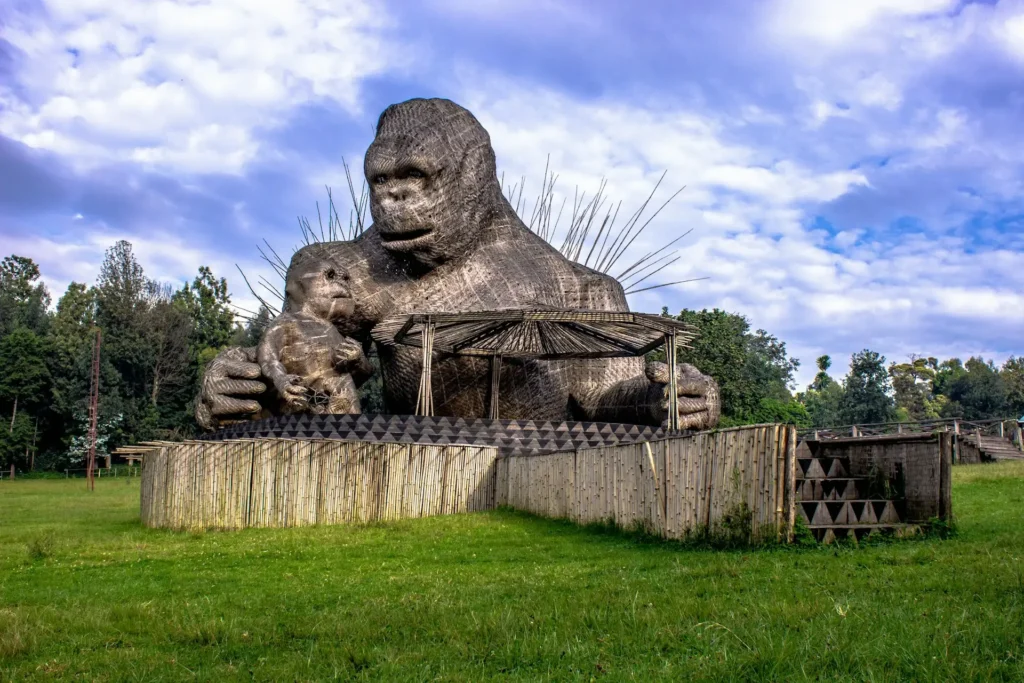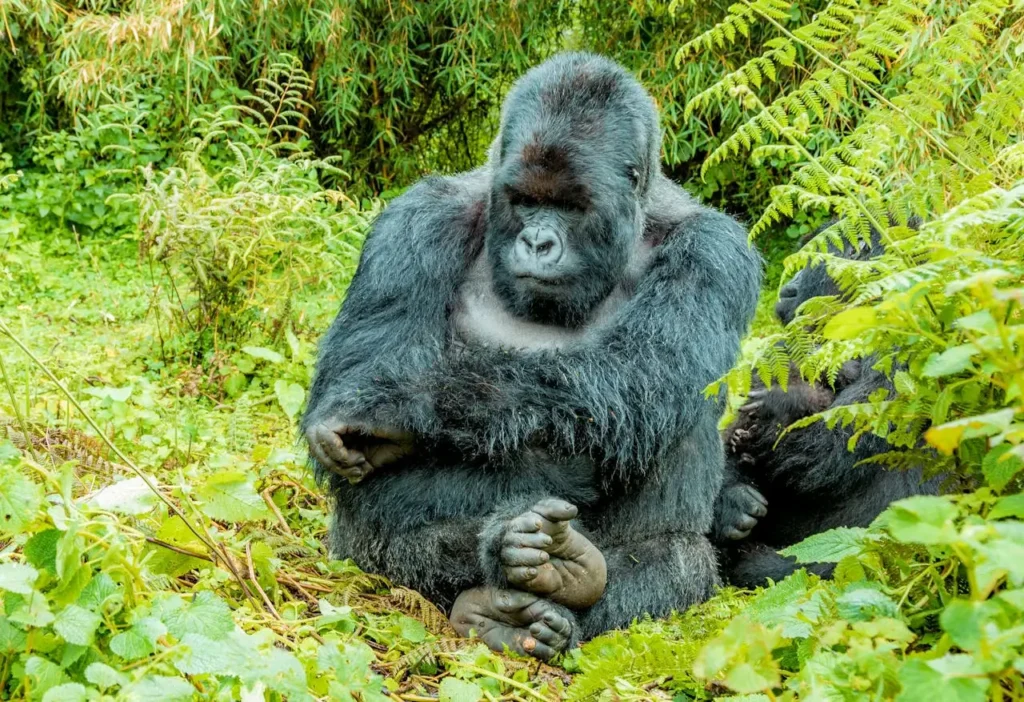There’s something about stepping into the mist-covered forests of Rwanda that fills you with a sense of wonder. As you hike up the lush, volcanic slopes of Volcanoes National Park, the thick jungle around you hums with the sounds of nature. Then, out of nowhere, a rustle in the underbrush signals the moment you’ve been waiting for. Suddenly, you find yourself face-to-face with a silverback gorilla, his piercing gaze meeting yours as he calmly goes about his day.
This moment is not just a chance encounter—it’s a once-in-a-lifetime opportunity to witness one of the world’s most endangered species up close. Gorilla trekking in Rwanda is more than just a physical journey—it’s an emotional, life-changing experience that leaves an imprint on your heart long after you leave.
If you’ve ever dreamed of coming face-to-face with these majestic creatures, you’re in the right place. In this comprehensive guide, we’ll cover everything you need to know before embarking on your own gorilla trekking adventure in Rwanda. From the best time to go, to what to expect on your trek, and even the conservation efforts that make these incredible experiences possible, we’ve got you covered.
Why Gorilla Trekking in Rwanda is a Must-Do Experience

Rwanda, often called the “Land of a Thousand Hills,” offers much more than its breathtaking landscapes. Among its top attractions is the rare opportunity to go gorilla trekking. Here’s why this experience should be at the top of your bucket list.
- A Rare and Intimate Encounter
Rwanda is home to over half of the world’s mountain gorilla population, making it one of the few places where you can experience this remarkable wildlife encounter in its natural habitat. Unlike other wildlife safaris where animals are often distant, the gorillas here are incredibly close—sometimes only a few feet away. This personal, raw encounter is the highlight of any trek. - Conservation Success Story
The mountain gorilla population, which once faced the threat of extinction, has made a significant recovery, thanks to dedicated conservation efforts. By trekking with gorillas, you’re not just witnessing these animals in their natural environment; you’re directly contributing to their ongoing protection and the broader conservation of Rwanda’s ecosystems. - Immersive Nature Experience
Beyond the gorillas themselves, Rwanda’s Volcanoes National Park is a haven of biodiversity, with its lush forests, misty mountains, and diverse wildlife. You’ll experience the untouched beauty of the park as you hike through it, surrounded by bird songs, rustling leaves, and the occasional sighting of other wildlife like golden monkeys and buffalo.
Planning Your Gorilla Trekking Adventure in Rwanda
Before you set out on your incredible journey, it’s important to plan your trip to ensure a smooth and memorable experience. Here’s everything you need to know.
Best Time to Go Gorilla Trekking in Rwanda
When it comes to gorilla trekking in Rwanda, the timing of your trip can significantly impact your experience. There are two main seasons to consider: dry and wet.
- Dry Seasons (June – September, December – February)
These months are considered the best time to go trekking. With less rain, the trails are easier to navigate, making the hike more enjoyable. Plus, the weather is generally cooler, offering more comfort during your trek. However, keep in mind that this is also the peak tourist season, so it’s wise to book your permits well in advance. - Wet Seasons (March – May, October – November)
While the wet season offers fewer tourists and potentially lower prices, it also means muddier trails and more challenging hiking conditions. Heavy rainfall is common, so it’s important to be prepared for wet and slippery terrain. However, if you don’t mind the rain, this can be a great time for a more secluded trek.
How to Get to Rwanda for Gorilla Trekking
- Flying Into Kigali
Rwanda’s capital, Kigali, is the main entry point for international travelers. From Kigali, it’s a scenic 2-3 hour drive to Volcanoes National Park, where most gorilla trekking tours take place. Depending on where you’re coming from, there are direct flights to Kigali from major cities around the world, including Nairobi, Addis Ababa, and Johannesburg. - Visa Requirements
Most visitors will need a visa to enter Rwanda, which can be obtained either online before your trip or on arrival at Kigali International Airport. Be sure to check the latest visa requirements based on your nationality before planning your travel.

Permits and Costs: What You Need to Know
One of the most important aspects of planning your gorilla trekking trip is securing your permit. Here’s a breakdown of the costs and what you need to know.
- Gorilla Trekking Permits
In order to trek with the gorillas, you must purchase a permit. As of 2025, permits are priced at $1,500 per person, and only a limited number are available each day to ensure the gorillas’ safety and minimize human impact. Permits are sold on a first-come, first-served basis, so it’s essential to book your permit well in advance—especially if you’re traveling during peak season. - Additional Costs
In addition to the permit, you’ll need to consider other costs, such as transportation to the park, accommodation, meals, and tipping your guides. Expect to pay for transport between Kigali and Volcanoes National Park, which typically costs around $100-$150 each way if arranged through a tour operator.
What to Expect During Your Gorilla Trek
Now that you’ve secured your permit and planned your trip, it’s time to dive into what you can expect on your actual trek.
The Trekking Experience: A Day in the Wild
Once you arrive at Volcanoes National Park, your guide will meet you early in the morning for a briefing on what to expect and the guidelines for interacting with the gorillas. Here’s how the day usually unfolds:
- Meeting Your Guide and Group
You’ll be assigned to a small group, usually no more than eight trekkers, along with an experienced guide and a ranger. Your guide will explain the trek’s logistics, the safety protocols, and the importance of maintaining a respectful distance from the gorillas. - The Hike
Depending on where the gorillas are located, your trek could take anywhere from 1 to 6 hours. The terrain varies, with some areas offering steep climbs, while others may be more level. The altitude and humidity can make the hike physically challenging, so it’s important to come prepared and stay hydrated. - Meeting the Gorillas
After your hike, the real magic happens. You’ll be led to the gorilla family you’ve been assigned to visit. Expect to be within a few feet of the gorillas, as they go about their daily activities—eating, playing, or simply resting. You’ll have an hour to observe and photograph these incredible animals, all while adhering to strict guidelines to ensure their safety and comfort.
Safety Guidelines and Responsible Trekking
To protect both you and the gorillas, there are important safety guidelines you’ll need to follow:
- Maintain a Safe Distance
You are required to stay at least 7 meters (about 21 feet) away from the gorillas. This distance is crucial to avoid transmitting any diseases and to minimize stress on the animals. - No Flash Photography
Flash photography is strictly prohibited to avoid startling the gorillas. Make sure to use your camera’s natural light settings. - Keep Quiet and Respectful
The gorillas may approach you, but it’s important to remain calm and avoid making loud noises or sudden movements. This ensures both your safety and that of the gorillas.

What to Pack for Your Gorilla Trek
Proper packing is key to ensuring a comfortable and successful trek. Here’s a checklist of what you’ll need:
- Sturdy Hiking Boots: The trails can be muddy and uneven, so sturdy boots with good grip are essential.
- Waterproof Gear: Pack a waterproof jacket and pants to protect yourself from rain and damp conditions.
- Lightweight Gloves and Long Sleeves: Protect your arms and hands from thorny plants and insects.
- Binoculars and Camera: While optional, these will enhance your experience when observing wildlife from a distance.
- Snacks and Water: The trek can be physically demanding, so bring water and high-energy snacks to keep you fueled.
Gorilla Trekking Etiquette: Do’s and Don’ts
While on the trek, it’s important to follow basic etiquette to ensure the safety and well-being of both you and the gorillas. Here are a few key tips:
- Respect the Wildlife: Don’t make sudden movements or loud noises that could startle or disturb the gorillas.
- Follow Your Guide: Your guide knows the park well and is there to ensure you have a safe, respectful, and enjoyable experience. Listen carefully to their instructions.
- Leave No Trace: Rwanda is dedicated to preserving its natural environment, so ensure you leave no litter behind and avoid damaging plants or trees.
Thank you for pointing that out! Let’s complete the article with the missing sections, maintaining the same engaging tone and detail. Here’s the rest:
Best Places to Stay When Gorilla Trekking in Rwanda
When it comes to finding a place to stay near Volcanoes National Park, there’s a wide range of accommodations that suit different budgets and preferences. Whether you’re seeking luxury, comfort, or a more budget-friendly experience, Rwanda offers plenty of options for a restful stay after your trekking adventure.
Luxury Lodges
For those seeking an ultra-luxury experience, the following lodges offer top-tier amenities, exceptional service, and breathtaking views:
- Bisate Lodge: Nestled on the edge of Volcanoes National Park, Bisate Lodge provides an exclusive stay with panoramic views of the Virunga Mountains. The lodge blends luxury with eco-consciousness, featuring beautifully designed villas and a focus on sustainability. Guests can enjoy guided treks, gourmet meals, and personalized service, making it the ultimate choice for high-end travelers.
- One&Only Gorilla’s Nest: Situated close to the park entrance, this luxury property offers comfort and opulence, complete with a spa, fine dining, and stunning views. The lodge is a great base for gorilla trekking, offering a truly immersive experience in the heart of Rwanda’s natural beauty.
Mid-Range Accommodations
If you prefer something more affordable without compromising comfort, consider these options:
- Volcanoes Virunga Lodge: With beautiful views of the Volcanoes National Park, this mid-range lodge provides a cozy and comfortable stay. The lodge offers both private and shared chalets, delicious local food, and a great location for easy access to trekking departures. It’s an excellent choice for those who want a more budget-conscious experience while still enjoying a high standard of accommodation.
Budget-Friendly Options
For budget-conscious travelers, there are several guesthouses and eco-lodges that offer affordable yet authentic experiences:
- Community-Run Eco-Lodges: Rwanda has several eco-lodges and guesthouses managed by local communities near the park, providing a more affordable stay. These lodges often offer a deeper connection to the community and are an excellent option for travelers who want to support local initiatives.
- Kinigi Guesthouse: Located just outside the park entrance, Kinigi Guesthouse provides basic, budget-friendly accommodations with welcoming staff. It’s a popular choice for trekkers looking to save on lodging without sacrificing convenience.
The Conservation Efforts Behind Gorilla Trekking in Rwanda
Gorilla trekking in Rwanda is not just a tourist attraction—it’s a vital component of a larger conservation effort that has helped save the mountain gorilla from the brink of extinction. Understanding the role of conservation in your trek can enhance the experience and allow you to appreciate the significance of your visit even more.
The Role of Rwanda’s Government
- Sustainable Tourism: The government of Rwanda has adopted a strong policy of sustainable tourism that directs a significant portion of revenue from gorilla trekking permits to conservation efforts. The income from tourism supports the protection of both the gorillas and their habitat, ensuring that the delicate balance between conservation and tourism continues to thrive.
- Gorilla Monitoring Programs: Researchers and park rangers are dedicated to the ongoing monitoring of gorilla families within Volcanoes National Park. These efforts involve regular health checks, tracking, and data collection to ensure that the gorillas remain healthy and safe. The information gathered helps conservationists better understand the gorillas’ behavior, health, and needs.
How Your Trek Supports Conservation
- Revenue from Permits: The $1,500 permit you purchase is directly reinvested into conservation programs. These funds help with anti-poaching patrols, habitat restoration, and research programs aimed at ensuring the continued survival of the mountain gorillas.
- Community Involvement: Many local communities around Volcanoes National Park directly benefit from tourism. From employment opportunities in hotels, restaurants, and transportation services, to participating in conservation projects, locals play an active role in preserving Rwanda’s wildlife and contributing to its economy. Your trek supports not only the gorillas but also the people who help protect them.
Conclusion:
Gorilla trekking in Rwanda is not just an adventure—it’s a profound experience that connects you to nature, wildlife, and the conservation efforts that are helping to protect one of the world’s most endangered species. As you hike through the misty forest, the thrill of encountering these incredible creatures in the wild will stay with you forever.
Whether you’re a seasoned traveler or a first-time explorer, your trek in Rwanda will be a journey you’ll never forget. So why wait? Pack your bags, secure your trekking permit, and get ready to embark on the adventure of a lifetime.
Ready to experience the magic of gorilla trekking in Rwanda? Book your permits today and start planning your unforgettable adventure!
FAQ About Gorilla Trekking in Rwanda
If you’re still unsure about what to expect on your gorilla trekking journey, here are answers to some frequently asked questions that can help clarify any lingering doubts:
What is the best time to go gorilla trekking in Rwanda?
The best time to go gorilla trekking is during the dry seasons, from June to September and December to February. These months offer the best trekking conditions, with drier trails and more comfortable weather for hiking.
How difficult is the gorilla trek in Rwanda?
The trek can be physically demanding, especially in the steep and muddy terrain of Volcanoes National Park. However, the effort is well worth it. Guides are available to assist trekkers, and the trek is suitable for most people in good health. If you’re prepared for a bit of a challenge, the experience will be unforgettable.
Do I need to be physically fit to go on a gorilla trek?
While you don’t need to be an athlete, having a moderate level of fitness is helpful. The trek can range from a relatively easy walk to a more strenuous climb, depending on the gorilla group’s location. If you’re in reasonably good shape and can handle some steep trails, you’ll be fine.
How many people are allowed to trek with the gorillas at one time?
Each gorilla group can accommodate a maximum of 8 trekkers per day. This limit helps reduce human impact on the gorillas and ensures that your experience is as intimate and respectful as possible.
